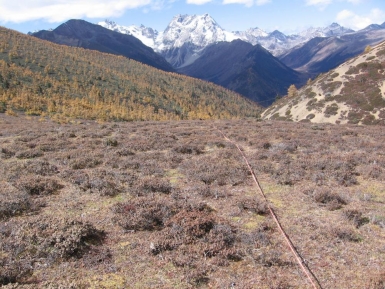Posted 08/2/11
The Chinese province Yunnan is a mountainous area with variety of beautiful landscapes: forest, shrub, alpine meadows, scree and snow alternate each other with elevation increase. Alpine meadows are very important for local people. Thousands of yaks browse on these meadows, and livestock is a source of food and money for residents of this area. However, the range of alpine meadows is declining in last decades because of shrub encroachment. Jodi Brandt investigates causation of these dramatic changes.

As part of her PhD project, Jodi Brandt studies shrub encroachment on alpine meadows. She uses Landsat images for comparison of shrub changes between years. Jodi found not much change between 1975 and 1990. However, by 2009 shrub coverage was 39% higher than in 1990! Most of these shrubs are Rhododendron species, which are poisonous for yaks. It means that local people have less and less pasture areas for their livestock.What are the reasons for shrub encroachment? Why do we have these dramatic changes in last two decades? Jodi hypothesized that overgrazing, temperature, snow coverage and burning regime changes could cause it.The number of yaks in her study area increased from 50,000 in year 1952 to 250,000 in 2000. To analyze the influence of browsing pressure, Jodi did gradient analysis and measured encroachment rate at different distances from roads. The road attracts people because they can easily sell and buy goods, so assumption was that browsing pressure would be higher close to roads. Indeed, Jodi found higher rate of shrub encroachment in the nearest to the road buffer zone, but even far away from the road this rate was quite high. So, she concluded that overgrazing was important but not the only reason of shrub encroachment.Jodi’s second hypothesis was that temperature changes influence the plant of alpine meadows. She analyzed temperature changes during the last decades. She found that minimum daily temperature in her study area increased from about 0 degrees C in 1980 to 1 degrees C in 2010. This is a dramatic change if we take in consideration, for example, that average temperature on the Earth increased by 0.33 degrees C from 1990 to 2006 (Rahmstorf et al. 2007. Science. V. 316. P. 709). Cold-tolerant alpine plants are very vulnerable to such changes.

The temperature increase affected both snowfall and rain. Though overall precipitation level remained the same, now much more precipitation falls as rain, rather than snow.Speaking about land tenure periods and fire regime, at the beginning of the 1900s the Tibetan areas of Yunnan province still had a feudal system. Landowners did not burn shrubs in the alpine very often. From 1958 to 1983, during the collectivization period, lands became public. In that time people burned alpine meadows regularly (54% of burnt area per year). Unfortunately, a lot of forest and farms were destroyed by fire, and in 1988 a national law prohibited fires. There are still some fires though – about 11% of area is burnt every year. Jodi and her collaborators estimated age of shrubs in some studied territories. It turned out that oldest rhododendrons were established in year 1988 – the year when fires were prohibited. The oldest shrubs of other species were established before, but it is rhododendron shrubs which are most abundant now in Jodi’s study area.So, all factors Jodi analyzed were correlated with shrub encroachment. She concludes that ecosystem succession in Yunnan mountains are results of very complex interaction between land use change, state policy regimes and temperature oscillation. style=text-align: center;>

“
Story by Bragina, Eugenia
